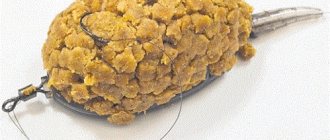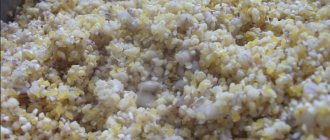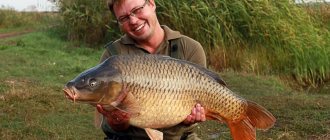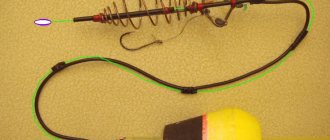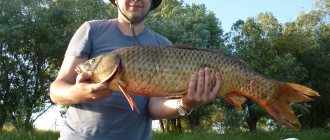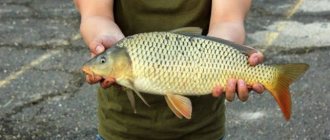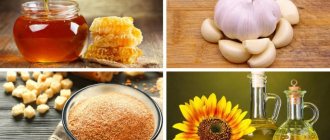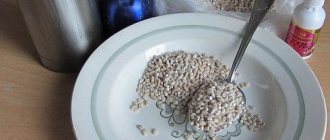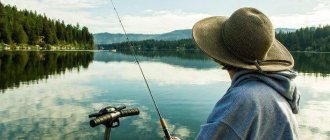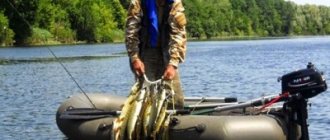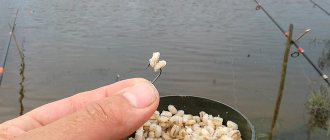Fishing with a spring is very convenient and easy. A spring clogged with porridge is used in bottom gear. You can buy it at any fishing store, and choose the size depending on the size of the intended fish.
The spring significantly increases the chances of catching a big fish. In order for the spring to give maximum results, it must be filled with the right mixture. This article was written specifically in order to find out popular porridge recipes, as well as indicate some of the features of such fishing.
How to prepare porridge for fishing?
To begin with, let us point out that there are a lot of porridge recipes. The main thing is that during the cooking process your porridge does not burn and does not turn out to be too rare. If your porridge burns, it will not give the effect we expect.
Let's highlight several popular cereals that most experienced fishermen use:
- Pea porridge;
- Hominy;
- Wheat porridge;
- Porridge from mixed feed.
The porridge should be cooked over low heat and stirred constantly to avoid the formation of soot. Let's look at the ingredients and cooking process for these porridges.
How to prepare porridge for a spring
There are many options for making cereals for feeders such as spring feeders. Along with this, there are recipes that deserve attention. Cooking porridges should be accompanied by a number of recommendations, taking into account the specifics of the equipment. Eg:
- It is possible to add all kinds of flavorings to the porridge. At the same time, you don’t need to get too carried away, especially with unnatural ingredients, so as not to scare away the fish.
- It is extremely important to achieve the right consistency: it should not be too viscous or too crumbly. If the porridge is too viscous, it will not dissolve well in water, and if it is too loose, it will fly out of the spring at the moment it hits the water. Based on this, cooking porridge, although simple, is an important point.
- It is possible to add sunflower cake to any porridge, which will serve not only as a flavoring agent, but also as a leavening agent. Using it, it is possible to adjust the thickness of the porridge.
- During preparation, be careful to ensure that the porridge does not burn; therefore, it is better to cook it over low heat, always stirring.
Pea porridge for spring fishing
Thanks to the properties of peas, preparing porridge from them is not difficult. Properly cooked pea porridge will provide you with a good catch. We will indicate a list of ingredients that we will need during the cooking process.
Ingredients:
- Pea cereal – 200 grams;
- Wheat cereal – 100 grams;
- Sugar – 1 tbsp. spoon;
- Salt - a third of a teaspoon;
- Soda - half a teaspoon.
During the cooking process, you need to ensure that the porridge does not burn and the water does not boil away.
The cooking process is as follows:
- Place the indicated amount of pea porridge on low heat. Don't forget to stir during the cooking process.
- When the porridge boils, remove the resulting foam with a spoon. When the porridge boils, it needs to be cooked for another ten minutes.
- Add soda and mix well.
- After the peas are completely boiled and puree is formed, you need to add wheat grits. Stir and leave to cook for another 15 minutes.
- Turn off the heat, add salt and sugar. This will help enhance the smell. You can also use macadamia to enhance the taste.
- Leave the porridge and wait for it to absorb moisture. After this it should become very viscous.
We are waiting for it to cool down. That's it, our porridge is ready to use.
Recipes
Let's move on directly to the consideration and description of the most popular porridge recipes used by our fishermen for catching carp using a spring feeder.
Hominy
Popular in Moldova and Romania, porridge is also excellent for carp fishing. It is very plastic, holds well in any of the nipples, and the fish really like the taste.
The main ingredients are corn and wheat flour. Corn is rarely found on sale, so usually the cereal found in any supermarket is ground in a coffee grinder.
When choosing cereals, make sure that there are no foreign inclusions inside the package: debris, pebbles, etc.
Prepare hominy with your own hands in the following sequence:
- Fry corn and wheat flour in a ratio of three to one in separate pans until a pleasant smell appears.
- Mix both products thoroughly.
- Add warm water and knead the dough until the consistency of good sour cream.
- Add the flavor you think is necessary and mix everything.
- Place the dough in a double plastic bag for strength and tie it.
- Place the bag in a saucepan and add water until it covers the contents.
- Cook for 30–40 minutes, then turn off the heat and leave the porridge to cool directly in the water.
The longer we cook, the denser the hominy becomes. To fill the feeder, the porridge must be soft and plastic, so approximately thirty minutes is enough.
Advice! To use it as a nozzle, you need a higher density, so we cook the hominy for 10–15 minutes longer.
Millet porridge with potatoes
Potatoes have long been used as bait for carp. To fill the feeder, simple puree is not suitable because it is quickly washed away by water. Therefore, the fishermen thought of combining potatoes with millet porridge, which is also very attractive to our today’s hero.
In bait, potatoes and millet complement each other.
This bait is prepared in the following sequence:
- Boil the peeled potatoes and prepare the usual mashed potatoes using the water in which they were boiled and egg yolk.
- Separately, cook the millet until soft.
- Mix the ingredients.
- Add beaten egg white, pre-steamed and softened sunflower cake. Instead of cake, you can use sunflower seeds fried and minced in a meat grinder.
- After the mixture has cooled, add finely chopped fresh dill or mix in a diluted attractant.
We transfer the bait into a bag and put it in the refrigerator. When fishing, you can add chopped worms, bloodworms or maggots to the porridge.
Attention! Millet porridge for catching carp with a spring can be mixed with halva or steamed rolled oats flakes, flavored with honey or jam.
Pea porridge
Almost all fishermen know how carp and carp love peas in any form. There are several recipes for filling the pacifier feeder; here are two of the most popular ones. First, let's look at a simple pea porridge.
- Fill the washed peas with water in a ratio of five to one (a liter of water per glass of peas), leave for 8–10 hours.
- Without draining the water, place the pan on the fire or in a water bath.
- After bringing the water to a boil, reduce the heat to medium.
- Cook, stirring constantly for 8–10 minutes.
- Add a teaspoon of soda. At this point, the peas have already thickened enough and become slightly soft.
- Reduce the heat to low and add about half a glass of semolina or millet cereal.
- After cooling, we flavor and supplement the mixture with honey, halva, sugar - everything that can please the sweet-toothed carp.
The finished porridge should be plastic so that it can easily fill any feeder.
Pea-semolina mastyrka
Pea-semolina mastyrka is prepared a little differently, which is good both as bait and as bait for carp and related fish.
It is prepared a little differently than described in the above recipe. For one part of semolina we take two parts of peas.
- Boil the pre-soaked peas until smooth.
- Without removing from the stove, while constantly stirring the mixture, gradually introduce dry semolina.
- When the mixture becomes thick enough, remove the pan from the stove and place the product on the board.
- After cooling, when your hands can tolerate the temperature of the mass, we begin to knead the dough.
The finished mastyrka should easily roll into balls. Advice! Pea-semolina mastyrka itself is quite aromatic, but if desired, you can add honey, vanilla or other attractants.
Salapinka for spring
The famous Salapin porridge can also be adapted for fishing with a spring nipple. To do this, the recipe needs to be slightly adjusted so that the porridge becomes more plastic and non-crumbly.
The process is:
- Cook one part pearl barley in five parts water until half cooked.
- Add two parts of millet.
- Add a vanilla bag and a spoonful of unrefined sunflower oil to the pan.
- Cook over low heat, covered, until characteristic bubbles form.
- Remove the splits and add one part of corn grits.
- Knead the dough, gradually adding wheat, corn or pea flour.
The finished bait is plastic, balls can be easily rolled out of it for casting from the hand. In a spring or flat feeder, the modified salapin should hold well.
Porridge from mixed feed for spring fishing
How to prepare porridge for fishing on a feeder for crucian carp
Compound feed is a cheap product obtained by processing grain crops, enriched with vitamins and minerals, intended for feeding animals, including fish. The process of preparing porridge from it is simple, but requires control. The main thing is to get the porridge of the desired thickness.
Porridge according to this recipe is prepared as follows:
- Boil potatoes in their jackets, two to three pieces depending on size.
- Add feed to boiling water at a ratio of four to one.
- Cook for ten minutes after boiling again.
- Take the crumb of rye bread, crumble it and add it to the porridge.
- Mash the potatoes until pureed and place in a saucepan.
- Add a tablespoon of sunflower oil and mix everything thoroughly.
- To flavor it, add just a little vanillin, literally at the tip of a knife.
If everything is done correctly, you should get a thick, viscous mass from which you can roll balls and hammer the spring feeder with it.
Before preparing the porridge, it is better to steam the hard granules.
Semolina porridge with rolled oats
Semolina is added to many bait recipes; fish from the carp family really respect it. If you prepare semolina porridge with rolled oats, you can get a universal bait.
Cooking porridge can be divided into the following stages:
- Pour a glass of water into the pan and place it on the stove.
- After the water has boiled, add two teaspoons of oatmeal into the water.
- Add a teaspoon of sugar here and mix everything.
- After white foam appears on the surface, pour a glass of semolina into the container, gradually in small portions with constant stirring.
- After all the water has been absorbed, the porridge should be gently pressed on top.
- Wrap the container with a towel and leave it in this state for 15 minutes.
- Then knead the resulting mass thoroughly so that there are no hard lumps.
Advice! You can add a couple of drops of anise or dill oil as a flavoring.
Millet porridge
Many fishermen choose simple millet porridge from a variety of recipes, to which various components are added to flavor and improve taste. Millet can be prepared in different ways:
- cook on the stove
- cook in a slow cooker,
- simmer in the oven.
The main thing is that the porridge does not turn out crumbly, but slightly sticky. To do this, reduce the amount of water by half: optimally for a glass of cereal - two glasses of water.
The viscosity of the porridge should ensure its reliable retention in the feeder. To do this, you can add blinding components, for example, crushed oatmeal.
After the millet porridge is ready, the preferred additives are added to it:
- honey,
- vanilla sugar,
- cinnamon,
- berry syrup.
- dill,
- garlic,
- anise.
Hominy for spring fishing
Usually, mamaliga refers to corn porridge. This porridge is very simple to prepare, and the effect is wonderful. The finished hominy should be bright yellow and smell very good.
Wash the pan well, as well as your hands. This porridge absorbs odors very well. Therefore, everything must be absolutely clean. As a result, you need to get a cool mass that can easily be put into a spring. We will indicate a list of ingredients that need to be used when preparing mamalyga.
Ingredients:
- Corn flour – 300 grams;
- Wheat flour – 100 grams;
- Water – 1 liter;
- Sugar – 1 teaspoon.
Recipe:
- Heat a frying pan and fry the cornmeal for a few minutes. Add a few drops of sunflower oil and stir constantly.
- Add wheat flour and continue frying for a few more minutes.
- Make the fire low and add the specified amount of water. We try to stir the porridge more often. Within 10 minutes, the porridge should absorb water and become viscous. Add any flavoring (makhakha, vanillin, etc.)
- Turn off the heat and leave the porridge. After the porridge has cooled, divide it into two parts and place it in two plastic bags. Tie the bag tightly, stir the porridge into the water and cook for half an hour over low heat.
- Then leave the porridge in the same water overnight. And in the morning the porridge will be thick and can already be used.
There is another recipe for making mamaliga:
- To do this, put the specified amount of water on the fire.
- After the water has boiled, pour in the porridge and stir constantly for 30 minutes.
- Turn off the gas and leave the porridge to cool in a cool place. When the porridge cools, it will be very viscous.
Recipes for preparing bait for fishing at different times of the year
What's best for summer?
In hot summer weather, carp stay in reeds or other river vegetation.
Recipe with rye breadcrumbs
Ingredients:
- Powdered milk 250 ml.
- Rye crackers, ground in a coffee grinder – 1 cup.
- Soy flour – 1 cup.
- Egg powder – 0.5 cups.
- Sugar - 1 teaspoon.
- Salt – a pinch.
Mix all ingredients, add water from the pond.
Potato recipe
Ingredients:
- Boiled potatoes -1 kg.
- Raw egg 1 pc.
- Seeds - 1 cup.
- Cake – 1 glass.
- Dill seeds.
Mash the potatoes and add the egg. Grind the roasted sunflower seeds and dill seeds and add to the overall mixture. Steamed cake is in there too. Mix all ingredients well and form into a ball the size of an orange.
For autumn
Ideal bait for fall fishing
Ingredients:
- White fish -100 gr.
- Bird food -150 gr.
- Semolina - 110 gr.
- Fresh capelin 60 gr.
- Egg powder 30 gr.
- Casein fractions 30 – 85 g.
- Eggs – 6 pieces
- Fish oil -20 ml
- Fruit flavor 5ml
Mix fish, bird food, egg powder, casein well. Add raw eggs, fish oil and flavoring. Cook after boiling for another two minutes.
https://youtube.com/watch?v=mQuzmzLVJ4o
For spring
In spring you can catch some really big carp. But to ensure success in fishing, you need the right bait. It is more advisable to feed in places with a maximum depth of 2 meters, and do the fishing itself from the shore.
A simple, but very effective and proven bait for spring
Ingredients:
- Corn 1 kg.
- Wheat 1kg.
- Flavor bottle (fruit or berry) - 50 ml.
- Sugar 100 gr.
Rinse the cereals well in water. Fill with water so that there is five centimeters from the contents to the surface. Add flavoring, it is better to take anise or hemp and sugar. Stir everything until the sugar is completely dissolved. Place the container in a warm place to ferment for two days.
Carp like this bait for several reasons:
- The persistent smell of fermentation is very attractive to fish.
- Such food is easier to digest than dry cereals.
- A simple composition without spraying is not liked by other small and nimble fish, so the carp can get to it first.
For winter
With the onset of cold weather, carp begins to reduce its appetite and diet. To gain fat, fish look for protein foods. Therefore, canned fish in oil, fish oil, and fish meal are added to the bait. In winter, carp are less active, so catching them requires a lot of patience. The bite will most likely be in the deep part of the reservoir. The bait should be small in size with not very dusty components. You can use maggots as a basis, after scalding them with boiling water. Live larva can scare winter carp
Feeding must be done with extreme caution in small portions. In winter, carp are very capricious in their choice of food and are calm, and food is needed only to stir it up
Quick bait from improvised means
There are times when you urgently need bait, but you don’t have it prepared. The way out of this situation is simple bait from what is at hand or what can be easily found in any stall.
Ingredients:
- Seeds.
- Cocoa.
- Black bread.
Soak the bread in water, squeeze out the excess, add cocoa and seeds.
Recipe No. 2
Ingredients:
- Breadcrumbs for breading.
- Canned corn.
Pour half a can of corn into the bag. Let's crush it there. Add the remaining corn whole. We also pour the liquid from the jar into the bag. Breadcrumbs are needed as a binder.
If there is no store nearby, use live ingredients. They can be found by running a net along the bottom of the reservoir. These are all kinds of larvae, crustaceans, leeches, and babies. Great luck for you if there is a field nearby with corn, sunflowers, rye, and wheat. It’s good if you find acorns, chop them up and fry them over a fire. Armed with a shovel, go to the field and dig up worms there.
Millet porridge for spring fishing
In addition to the fact that millet can be used in the preparation of other porridges. You can make a separate porridge from it. The list of ingredients is very simple.
Ingredients:
- Millet porridge – 200 grams;
- Water – 100 grams.
Recipe:
- Put the water on the fire and bring it to a boil.
- Add millet porridge and cook for 30 minutes over low heat. Don't forget to stir constantly.
In some cases, you can combine such porridge, for example, with wheat or pearl barley porridge. To do this, during the cooking process we simply add another type of porridge. When you stuff a spring with this mess, you need to compact it very well so that it doesn’t spill out in the water.
What is porridge for and how does it work?
There are fishermen who are distrustful of porridge, which acts as bait, although it more than justifies itself. There are times when, having taken all sorts of goodies for fishing, it turns out that all of them do not attract fish one bit.
As for porridge, it allows you to both attract many specimens to a place and keep them there. The crucian carp is lured by the aroma itself, so it is quite possible that he will not begin to greedily absorb the product that was provided to him. However, it will begin to swim around it. Moreover, this can continue for quite a long time. Therefore, there is no need to save on porridge.
In order to achieve the maximum effect, half an hour before the start of fishing you should feed the fish and only after that use aromatic bait. Experienced people note that this trick almost always works flawlessly.
It must be said that the nozzle is used depending on the time of year. In the warm months, grain, pearl barley or makha are suitable, and in the cold months, you won’t find better than bloodworms, worms, maggots or flies.
Porridge from mixed feed for spring fishing
Compound feed is a mixture of grain crops. To make feed, you need to grind and compress a certain amount of grain mixtures. This porridge is used to catch most popular fish.
Ingredients:
- Half a kilogram of feed;
- Rye bread – 1 loaf;
- Potatoes – 2 pcs. cooked;
- Sunflower oil – 1 tbsp. spoon
- Water – 2 liters.
As with all baits, the important condition is to create a thick consistency that can be placed in the spring.
The cooking process is as follows:
- Put the water on the fire and bring it to a boil;
- Add feed porridge and cook for 15 minutes, stirring constantly;
- Cook the potatoes;
- Remove the crust from the rye bread and add it to the feed porridge;
- Remove the peel from the boiled potatoes. Crumble it and add it to the mixture of bread and feed;
- Add the specified amount of sunflower oil and mix.
To enhance the smell, you can add a little vanillin. This will help enhance the scent and attract more fish. The result should be a very viscous mixture that will easily fill the spring.
Making your own bait
Sunflower cake is a very fragrant component of bait
For various reasons, many provincial fishermen cannot purchase good branded baits. Therefore, they continue to attract carp and carp with homemade culinary “masterpieces.”
Recipe No. 1
One of the simplest but most effective recipes is boiled barley with peas. Barley and peas are the main components; various additives and flavorings can be added to them. This type of bait is suitable for putting into the feeder and for baiting the fishing spot.
Yellow peas are used for cooking. Before putting peas on the stove, you need to fill them with water and let them steep for 24 hours. If you don’t have that much time to prepare the bait, you can get by with soaking the peas for 12 hours. After this, put the peas on low heat and cook. On average, peas should cook for about 2 hours. For bait, it is not a problem if the peas are boiled, but if you are going to also use them as bait, it is better to carefully monitor their readiness. The finished peas can already be crushed with your fingers. When lightly squeezed, it shrinks, but its skin does not burst and the peas do not fall apart.
The pearl barley is cooked over low heat for an hour. For 1 liter of water you need to add about 200 grams of pearl barley. After the barley is cooked, remove the pan from the heat, wrap it in a rag or towel - this way the barley will be completely cooked.
Well, then you will need to mix the prepared peas with the prepared pearl barley. You can add feed, halva, cookies, flour, commercial bait or any other ingredients to this mixture. For scent, you can add commercial flavoring, anise, hemp or sunflower oil.
The bait, due to pearl barley, turns out to be quite viscous, holds well in the feeder and works great when feeding the fishing area. You can also add boiled or canned corn to it, this will help attract carp.
Recipe No. 2 (dry composition of bait for carp and carp)
- ground oatmeal cookies - 1 kg;
- crushed baked milk cookies - 0.5 kg;
- ground roasted peanuts - 0.5 kg;
- wheat breadcrumbs - 1 kg;
- corn grits - 1.5 kg;
- corn flour - 1 kg;
- mixture of crushed flakes (oatmeal, corn, wheat) - 1 kg.
Once moistened, flavorings or animal ingredients can be added.
Anglers developed this recipe as a variant of feeder bait for carp, intended for feeding into fishing zones in method and spring feeders. To prepare the paste you need fresh halva and semolina. These ingredients are mixed together and lightly steamed in a water bath. As a result, they receive complementary food in the form of a plastic dense mass that rests securely on the ribs of the open feeder.
Salapinka
Salapinka was originally a bream bait, but it perfectly suited the conditions for catching carp in strong currents. The food is prepared on the basis of a porridge brew mixed from pearl barley and millet. After cooking, barley or corn flour is added to the porridge to loosen it. The composition is mixed to a thick and plastic consistency, which helps keep the ball of complementary food at the bottom in fast-moving water for a long time. Already near the reservoir, an animal component in the form of crushed bloodworms, chopped worms or shells is added to the home-brewed mix, and the mixture is also saturated with an attractant. This recipe for bait for carp with large quantities of animal components is used in the spring when the water is not yet warmed up enough.
Recipe No. 3. Protein
- 1/4 pearl barley porridge;
- 1/3 cottage cheese;
- 2 mashed green peas;
- 1/3 feed;
- 2 roasted hemp seeds;
- add some mint oil;
Mix everything thoroughly.
Recipe No. 4. Nutritious protein
Take:
- 5 parts steamed wheat with salt;
- 3 crushed roasted sunflower seeds;
- 2 corn flour;
- 3 cottage cheese;
- 3 pureed shell meat;
- 3 raw egg yolks;
Mix everything. Add two parts of beans cooked in castor oil and a few drops of anise oil.
Recipe No. 5. The simplest and most effective bait
Place the cake and steamed wheat in a gauze bag and lower it to the bottom of the reservoir. The carp quickly finds such food, but cannot eat it because of the small holes in the gauze. This will provoke him, and he will not leave this place for a long time.
Features of spring fishing
Fishing with a spring is a fairly common way of fishing. With the help of a spring you can catch a fairly good specimen. I most often use the spring for fishing for crucian carp or crucian carp.
With the help of bait, which clogs the spring, the fish swims up to the bait and bites. The spring is very convenient to use; it can be filled with various baits.
Note that fishing with a spring significantly increases your chances of catching a large fish. The spring is best used on reservoirs in which there is no current. This is explained by the fact that the fast current washes the bait out of the spring. And the use of such equipment becomes impractical.
For the spring you need to use a fishing rod that is equipped with a reel. You need to hook the fish at the first sign of a bite. You will feel the force as the fish feeds the bait from the hook. This is a sure sign of a bite.
If you need the bait to remain in the spring longer than usual, then use a “harvester”. This spring is a cone made of metal wire. In this case, the bait will be washed out less and attract fish longer. Therefore, such tackle is used in reservoirs where there is a current.
What ingredients are used
Any carp bait is a multicomponent mixture consisting of small and large fractions, taste and smell enhancers, dyes and other elements. The main ingredients that are used in fishing in the reservoirs of our latitudes are:
- Sunflower cake. It has a strong and attractive aroma, capable of collecting carp from remote corners of the reservoir.
- Porridge – pearl barley, rolled oats, millet, egg, semolina. Individually or in combination they are the basis.
- Animal components – worm, bloodworm, maggot. They saturate the mixture with protein, increasing its attractiveness to fish in cold water.
- Coastal soil and water from a reservoir. Necessary to ensure the necessary viscosity of the feed. The color of the primer allows you to tint the mixture, adapting to the fishing conditions.
- Honey. The main natural flavoring and sweetener of groundbait. In addition, it increases its viscosity.
- Breadcrumbs. They provide the “dusting” properties of the food, increasing its visibility and attractiveness to fish.
In addition to the listed ingredients, individual mixtures may include nuts, various aromatic oils and liquids, animal feed, flour, milk powder, sugar, garlic, salt, cinnamon, coffee cake and other elements.
Tips for fishing with a spring
To ensure the most productive catch, you need to follow the recommendations, which we indicate below:
- You need to choose a fishing rod that is durable. The size ranges from 2.5 to 3.5 m. The rod must be equipped with a spinning reel;
- The fishing line is selected depending on the size of the intended fish. There is no need to use too thick a fishing line if you are catching small carp.
- For leashes, it is best to use braid. It will allow you to withstand great forces;
- The hook is also chosen depending on the size of the fish you are going to catch;
- We choose a spring that is not too large;
- It is best to have several springs in stock. If it gets snagged, you will replace it and continue fishing.
- The bait should be very thick . If the bait is rare, then you simply cannot put it in the spring;
- If you are a novice angler and are going to assemble the equipment yourself, then ask for advice from experienced anglers who will help you do it correctly;
- If you have no skills at all in assembling equipment, then buy a ready-made one;
Thus, we have considered all the important points regarding the preparation and use of porridge for the spring. We hope that our article helped you. Happy fishing!
